Unit7 Know Our World基础知识复习课件(共15张PPT)
文档属性
| 名称 | Unit7 Know Our World基础知识复习课件(共15张PPT) | 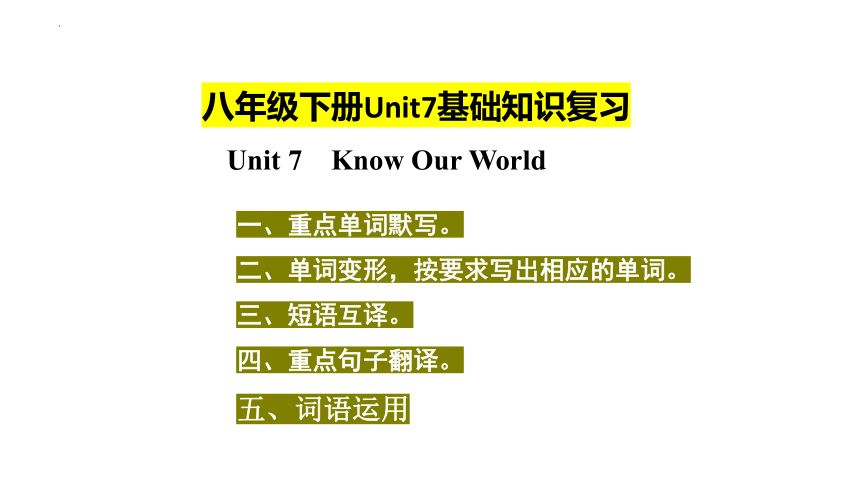 | |
| 格式 | zip | ||
| 文件大小 | 135.3KB | ||
| 资源类型 | 教案 | ||
| 版本资源 | 冀教版 | ||
| 科目 | 英语 | ||
| 更新时间 | 2022-05-07 20:45:15 | ||
图片预览

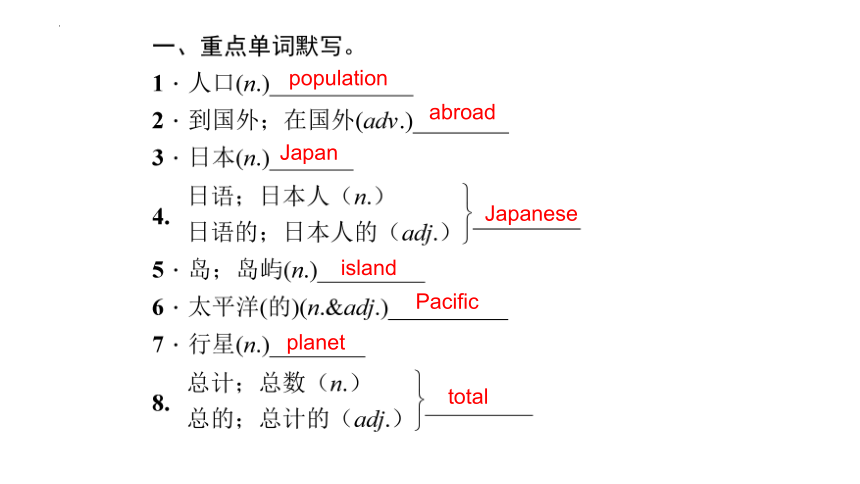
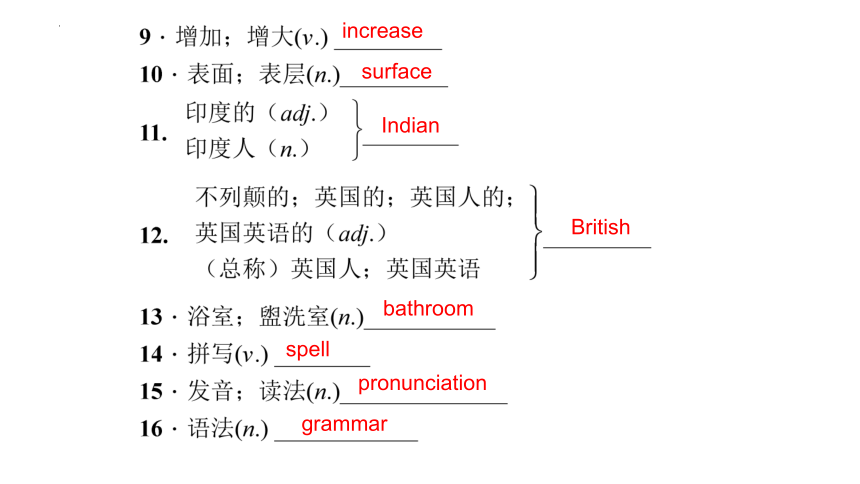

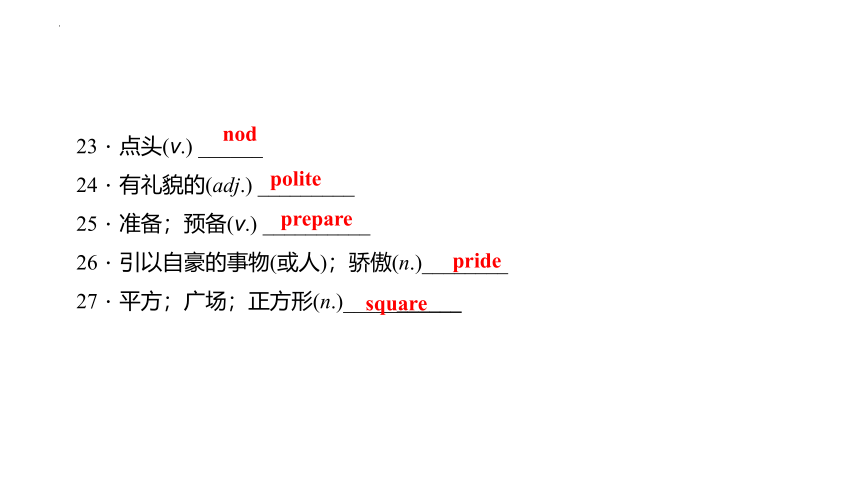
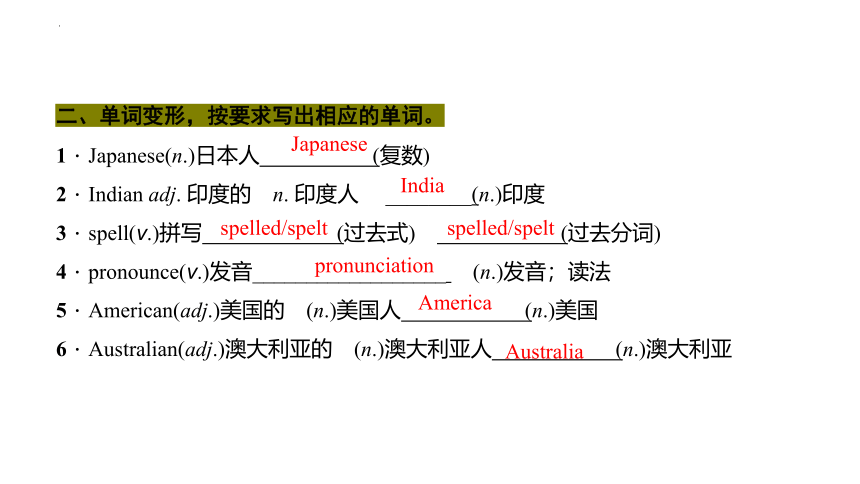
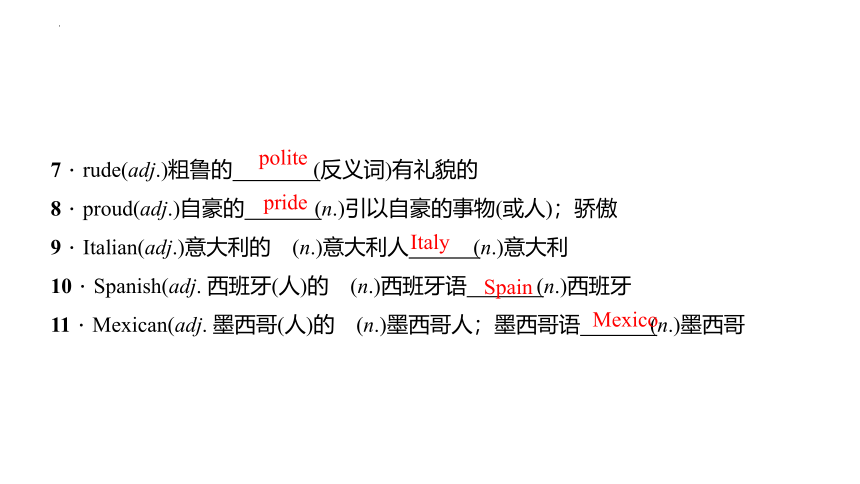
文档简介
(共15张PPT)
八年级下册Unit7基础知识复习
一、重点单词默写。
二、单词变形,按要求写出相应的单词。
三、短语互译。
四、重点句子翻译。
五、词语运用
Unit 7 Know Our World
population
abroad
Japan
Japanese
island
Pacific
planet
total
increase
surface
Indian
British
bathroom
spell
pronunciation
grammar
translate
American
Australian
pronounce
European
kiss
23.点头(v.) ______
24.有礼貌的(adj.) _________
25.准备;预备(v.) __________
26.引以自豪的事物(或人);骄傲(n.)________
27.平方;广场;正方形(n.)___________
nod
polite
prepare
pride
square
二、单词变形,按要求写出相应的单词。
1.Japanese(n.)日本人 (复数)
2.Indian adj. 印度的 n. 印度人 ________(n.)印度
3.spell(v.)拼写 (过去式) (过去分词)
4.pronounce(v.)发音__________________ (n.)发音;读法
5.American(adj.)美国的 (n.)美国人 (n.)美国
6.Australian(adj.)澳大利亚的 (n.)澳大利亚人 (n.)澳大利亚
Japanese
India
spelled/spelt
spelled/spelt
pronunciation
America
Australia
7.rude(adj.)粗鲁的 (反义词)有礼貌的
8.proud(adj.)自豪的 (n.)引以自豪的事物(或人);骄傲
9.Italian(adj.)意大利的 (n.)意大利人 (n.)意大利
10.Spanish(adj. 西班牙(人)的 (n.)西班牙语 (n.)西班牙
11.Mexican(adj. 墨西哥(人)的 (n.)墨西哥人;墨西哥语 (n.)墨西哥
polite
pride
Italy
Spain
Mexico
三、短语互译。
1.总计;合计;总共__________
2.三分之一_____________
3.被……覆盖_________________
4.三分之二____________
5.给……打电话___________
6.上升;升起___________
7.用不同的方式或方法___________________
in total
one third
be covered with
two thirds
ring up
go up
in different ways
8.shake hands________
9.be known for__________________
10.in recent years___________________
11.square kilometre_______________
12.The Great Lakes_____________
13.in area_____________
14.prepare for...______________
握手
因……而众所周知
在最近一些年里
平方公里
北美五大湖
在面积方面
为……做准备
四、重点句子翻译。
1.这些干旱的地方被叫作沙漠。
These dry places ______________deserts.
2.太平洋是最大的。
The Pacific is _____________one.
3.但是肢体语言在所有的文化中不是相同的。
But _______________is not the same in all ___________.
4.那是很多人口,但是比中国的人口少。
That is a ______population, but _________than _____of China.
are called
the largest
body language
cultures
large
smaller
that
五、词语运用
continents
population
A
Of the seven _______________1(continent) in the world, Asia is the largest one in area and ______________2(population). It covers more than 44 ___________3(million) square kilometres. It ___________4(be) home to more than 4 billion people. There are over forty countries in Asia and China is the ___________5 (big).
million
is
biggest
China is to the west of ___________6(Japanese). In China, when people ___________7 (nod) their heads, they mean “yes”; when people shake their heads, they mean “no”. But in India, these things mean the _________8. It is really interesting. __________9 most places, people point to things __________10 their fingers. But in some places, it’s rude. One body language is universal—a smile!
Japan
nod
opposite
In
with
B
Sometimes, people in the USA don’t say exactly what they mean. For example, “How are you ” is a nice question. It’s a ___________1(friend) way that people greet each other. The person who asks “How are you ” hopes to hear the answer “Fine.”, even i 2 the person’s friend isn’t fine.
friendly
f
The reason is that “How are you ” isn’t __________3(real) a question and “Fine.” isn’t really an answer. They are simply other ways of __________4(say) “Hello.” or “Hi.”
People also don’t say exactly what they are thinking when they finish __________5(talk) with other people. For e 6, many talks over the phone finish when one person says “I’ve got to go now.” o 7 “Someone’s at the door.” This might be true, or not.
really
saying
talking
xample
r
Perhaps the person doesn’t want to talk any m 8, but it isn’t polite to say that. The excuse is more polite, and it doesn’t hurt the other person.
W 9 they are greeting each other, talking about an idea, or finishing a talk, people don’t say exactly what they are thinking. It’s an _____________10(importance) way that people try to be nice to each other, and it’s part of the game of language.
ore
hether
important
八年级下册Unit7基础知识复习
一、重点单词默写。
二、单词变形,按要求写出相应的单词。
三、短语互译。
四、重点句子翻译。
五、词语运用
Unit 7 Know Our World
population
abroad
Japan
Japanese
island
Pacific
planet
total
increase
surface
Indian
British
bathroom
spell
pronunciation
grammar
translate
American
Australian
pronounce
European
kiss
23.点头(v.) ______
24.有礼貌的(adj.) _________
25.准备;预备(v.) __________
26.引以自豪的事物(或人);骄傲(n.)________
27.平方;广场;正方形(n.)___________
nod
polite
prepare
pride
square
二、单词变形,按要求写出相应的单词。
1.Japanese(n.)日本人 (复数)
2.Indian adj. 印度的 n. 印度人 ________(n.)印度
3.spell(v.)拼写 (过去式) (过去分词)
4.pronounce(v.)发音__________________ (n.)发音;读法
5.American(adj.)美国的 (n.)美国人 (n.)美国
6.Australian(adj.)澳大利亚的 (n.)澳大利亚人 (n.)澳大利亚
Japanese
India
spelled/spelt
spelled/spelt
pronunciation
America
Australia
7.rude(adj.)粗鲁的 (反义词)有礼貌的
8.proud(adj.)自豪的 (n.)引以自豪的事物(或人);骄傲
9.Italian(adj.)意大利的 (n.)意大利人 (n.)意大利
10.Spanish(adj. 西班牙(人)的 (n.)西班牙语 (n.)西班牙
11.Mexican(adj. 墨西哥(人)的 (n.)墨西哥人;墨西哥语 (n.)墨西哥
polite
pride
Italy
Spain
Mexico
三、短语互译。
1.总计;合计;总共__________
2.三分之一_____________
3.被……覆盖_________________
4.三分之二____________
5.给……打电话___________
6.上升;升起___________
7.用不同的方式或方法___________________
in total
one third
be covered with
two thirds
ring up
go up
in different ways
8.shake hands________
9.be known for__________________
10.in recent years___________________
11.square kilometre_______________
12.The Great Lakes_____________
13.in area_____________
14.prepare for...______________
握手
因……而众所周知
在最近一些年里
平方公里
北美五大湖
在面积方面
为……做准备
四、重点句子翻译。
1.这些干旱的地方被叫作沙漠。
These dry places ______________deserts.
2.太平洋是最大的。
The Pacific is _____________one.
3.但是肢体语言在所有的文化中不是相同的。
But _______________is not the same in all ___________.
4.那是很多人口,但是比中国的人口少。
That is a ______population, but _________than _____of China.
are called
the largest
body language
cultures
large
smaller
that
五、词语运用
continents
population
A
Of the seven _______________1(continent) in the world, Asia is the largest one in area and ______________2(population). It covers more than 44 ___________3(million) square kilometres. It ___________4(be) home to more than 4 billion people. There are over forty countries in Asia and China is the ___________5 (big).
million
is
biggest
China is to the west of ___________6(Japanese). In China, when people ___________7 (nod) their heads, they mean “yes”; when people shake their heads, they mean “no”. But in India, these things mean the _________8. It is really interesting. __________9 most places, people point to things __________10 their fingers. But in some places, it’s rude. One body language is universal—a smile!
Japan
nod
opposite
In
with
B
Sometimes, people in the USA don’t say exactly what they mean. For example, “How are you ” is a nice question. It’s a ___________1(friend) way that people greet each other. The person who asks “How are you ” hopes to hear the answer “Fine.”, even i 2 the person’s friend isn’t fine.
friendly
f
The reason is that “How are you ” isn’t __________3(real) a question and “Fine.” isn’t really an answer. They are simply other ways of __________4(say) “Hello.” or “Hi.”
People also don’t say exactly what they are thinking when they finish __________5(talk) with other people. For e 6, many talks over the phone finish when one person says “I’ve got to go now.” o 7 “Someone’s at the door.” This might be true, or not.
really
saying
talking
xample
r
Perhaps the person doesn’t want to talk any m 8, but it isn’t polite to say that. The excuse is more polite, and it doesn’t hurt the other person.
W 9 they are greeting each other, talking about an idea, or finishing a talk, people don’t say exactly what they are thinking. It’s an _____________10(importance) way that people try to be nice to each other, and it’s part of the game of language.
ore
hether
important
同课章节目录
- Unit 1 Spring Is Coming
- Lesson 1 How's the weather?
- Lesson 2 It's Getting Warmer!
- Lesson 3 Sun Is Rising
- Lesson 4 The Spring City
- Lesson 5 Babysitting on a Spring Day
- Lesson 6 Stories about Spring
- Unit 2 Plant a Plant
- Lesson 7 Planting Trees
- Lesson 8 Why Are Plants Important?
- Lesson 9 Gardening with Mary
- Lesson 10 Make Your Garden Grow!
- Lesson 11 Amazing Plants
- Lesson 12 Danny's Plant
- Unit 3 Animals Are Our Friends
- Lesson 13 Danny's Big Scare
- Lesson 14 Amazing Animals
- Lesson 15 The Zoo Is Open
- Lesson 16 The Pear Escaped
- Lesson 17 Save the Tigers
- Lesson 18 Friendship Between Animals
- Unit 4 The Internet Connects Us
- Lesson 19 How Do You Use the Internet?
- Lesson 20 A Computer Helps!
- Lesson 21 Books or Computers?
- Lesson 22 Travel on the Internet
- Lesson 23 The Internet--Good or Bad?
- Lesson 24 An E-mail to Grandpa
- Unit 5 Buying and Selling
- Lesson 25 Raising Money
- Lesson 26 Cookies, Please!
- Lesson 27 Business English
- Lesson 28 Ms. Liu's Great Idea
- Lesson 29 How to Push a Product
- Lesson 30 A Cookie Sale
- Unit 6 Be a Champion!
- Lesson 31 Don't Fall, Danny
- Lesson 32 My Favourite Record
- Lesson 33 2800 Years of Sports
- Lesson 34 Modern Olympics
- Lesson 35 The Dream Team
- Lesson 36 Classroom Olympics
- Unit 7 Know Our World
- Lesson 37 Let's Learn Geography!
- Lesson 38 The World Is a Big Place
- Lesson 39 Ring Up or Call?
- Lesson 40 Body Language
- Lesson 41 A Class of the World
- Lesson 42 North America
- Unit 8 Save Our World
- Lesson 43 Let's Clean Up!
- Lesson 44 Environment Clubs
- Lesson 45 Let's Sort Garbage!
- Lesson 46 Protect Our Environment
- Lesson 47 Connected to Nature
- Lesson 48 Garbage Is Interesting!
